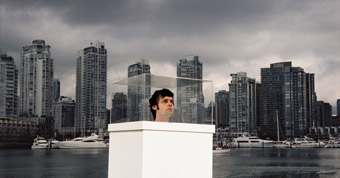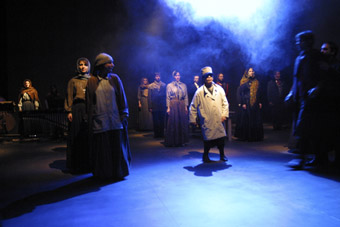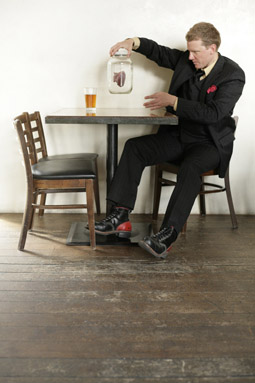yoga land & crack alley square off
alex lazaridis ferguson: vancouver theatre’s innovators

Promotional image, Radix Theatre, Assembly
courtesy the artists
Promotional image, Radix Theatre, Assembly
YOU’VE ARRIVED IN YOGA LAND WHERE SELF-ACTUALISED SPIRITUAL SEEKERS FREQUENT WESTSIDE CAFES AND BEACHES, THEIR UNLEASHED DOGS GENTLY PATROLLING THE OUTER LIMITS OF THEIR EXPANSIVE PASTEL AURAS; PAY NO ATTENTION TO THE JUNKIES AND THE HOMELESS ACROSS TOWN.
Let me restate that from across town: you’ve arrived in crack alley where crystal meth and heroin flow like an open sewer at Canada’s largest street market for illicit drugs; pay no attention to the spiritual seekers except when they drive by looking for a fix. Vancouver is both the yoga capital of Canada and home to the nation’s poorest urban neighbourhood, the downtown eastside (DES).
In many ways middle-class Vancouverites—due to a mix of guilt, fear, and curiosity—use the DES as a badge of authenticity. The neighbourhood confers both grit and compassion: “We care”, our yuppies might say, “Look at the needle exchange programs and look at Insite, North America’s first safe injection site.”
crime and punishment
Many of Vancouver’s innovative theatre companies also like to wear this badge. Several have created work in which the DES is a major focus, as in the 2005 adaptation of Dostoyevsky’s Crime and Punishment. The show was the culmination of years of collaborative work by DES community members, Vancouver Moving Theatre and director James Fagan Tait. Over the years they put on a number of large-cast productions featuring predominantly untrained performers from the neighbourhood. In 2005 they joined with Neworld Theatre and the PuSh Festival to create Crime and Punishment, a watershed production in the local scene. The adaptation featured three musicians and 21 actors (a cast size unheard of due to the usual budget constraints), four of them untrained performers from the DES. In the process, Tait drew upon well-established European theatre traditions going back to Meyerhold and Reinhardt, with a nod or two to more recent phenomena like Les Mis. A beautifully stripped-down musical score composed by Joelysa Pankanea for marimba, violin and double bass held together the choral work—sung, chanted or spoken in unison.
While the kind of critical distance advocated in Brechtian acting theory was well represented, the direct-address delivery of 21 performers calmly stating in unison, “You are walking down the street”, had such force that spectators were drawn into identification—not so much with individual characters (although that was part of it) but with a community of diverse performers. The dominant tendency to equate realism with truth in North American theatre was replaced by the hyper-realism of foregrounding the actor body—nothing as extreme as Romeo Castelluci’s Giulio Cesare in which the female parts are played by two emaciated women suffering from bulimia, and in which Antonius (Mark Antony) is played by a man with no larynx who can only growl through his throat into a microphone. But the goal was not to alienate, it never is in Vancouver theatre, which is always haunted by New Age spiritualism, even when trying to face the grim realities of a class structure we don’t talk about.

Crime & Punishment, Neworld Theatre
photo Tim Matheson
Crime & Punishment, Neworld Theatre
It was Tait’s treatment of the performers’ bodies that anchored Dostoyevsky’s 19th-century novel in the here-and-now of Vancouver. Dramaturg DD Kugler probably put it best when he said he felt he was seeing, for the first time, a cross-section of the city on stage. Others (mostly from the large regional theatre crowd) argued that it was the polish of the professional actors that kept the show together. My personal view is that the material and spiritual struggle of the novel was best embodied by Steve Lytton, an intense actor from the community who always held the downstage centre spot when the chorus of 21 got into position. Lytton suffers cerebral palsy; as a result his right leg lags behind his left. When the chorus entered, the first thing heard was Lytton’s walk. This actor’s particular physicality, matched with the riveting intensity of his performance (itself influenced by the effort it took him to get from point A to B), made it hard to get lost in the fiction. You couldn’t completely lose sight of this performer’s body. In this sense there is, indeed, overlap between Tait’s unsettling of the actor-character relationship in Crime and Punishment and Castellucci’s in Giulio Cesare.
In foregrounding the performers’ bodies, Tait was able to set up a tension between the actors and their fictional referents. The spectator suffered, or enjoyed, a double vision: 19th-century St Petersburg slum and 21st-century Pacific Coast city. In foregrounding the actual, Tait sought an authenticity of body that is unique because it is local, and because the uniqueness of each performance denies the possibility of using an analogous mix of professional and community actors in another city to replicate the event conditions.
assembly
This February I directed Nanay, a testimonial play about Filipino domestic workers in Canada, for Urban Crawl at the PuSh Festival. It was performed at the Chapel Arts Center, a former funeral home situated right in the heart of the DES. In attendance was a German presenter who told me that in Nanay she felt she was seeing Vancouver on stage at the festival for the first time. I failed to ask her what exactly she meant by that. Upon reflection I wonder if it was the fact that it featured Filipino-Canadian actors encountered in gritty settings? Or was it the unusually high number of Filipinos in attendance at a theatre event? Finally, was it simply the geographical location of the venue? I recommended the German presenter check out Radix Theatre’s Assembly. She had, and didn’t feel there was anything particularly local about it. I had to disagree.
Assembly is the quintessence of New Age Vancouver, albeit approached with an eye for parody. The show was sited in a hotel conference room, the kind of place you go to for a self-help seminar. This was, in fact, the conceit. For the first half of the show an interactive seminar took place in which the spectators were encouraged to openly express their unfulfiled desires. Seminar leadership by the Radix team eventually broke down and the spectators became witness to some very uncomfortable personal confessions. Partly scripted, partly improvised, the performers wove autobiography with fiction. The biographical parts gave an air of authenticity to the performances; in fact, with most of the ‘testimony’ it was impossible to tell fact from fiction.
When the confessions became just a little too raw, the spectators were led into another room, where they were confronted with surrealistic images of actors’ heads in glass boxes, seemingly random videos, naked actors on slabs in front of projected beach scenes, and a monologue about time traveling molecules. Here Radix was returning to one of its recurring preoccupations: the body’s relationship to constructed spaces.
In the past Radix has used the DES as an architectural palette. The concern here has not been with the neighbourhood bodies themselves, but with how bodies shape, and are shaped by, architecture. In Assembly, Radix made a departure (not necessarily for the first time) from the architectural imprint of the DES, with its tendency to fracture identity, and fully confronted the New Age spiritualist’s yearning for wholeness. Bucking postmodernist insistence on fragmentation, artistic directors Andrew Laurenson and Paul Ternes consciously made a show about “getting together.” They did so by setting up the logic of a self-help seminar, debunking notions of success that go with it, throwing the spectator into a surrealistic world which defies navigation by rationalist compass and, finally, by the simple act of having the performers tell stories of personal significance to spectators in an intimate, candle-lit setting. They accessed Yoga Land’s promises of spiritual wholeness, while putting into question its claims and methods.

David McIntosh, Battery Opera, Lives Were Around Me
courtesy the artists
David McIntosh, Battery Opera, Lives Were Around Me
lives were around me
In January, Battery Opera charted Eastside geography with a very intimate guided tour called Lives Were Around Me. Battery Opera is a dance/theatre company that sometimes blends disciplines and sometimes keeps them apart. In Lives (a theatre piece) an audience of four was guided through the streets and into a local pub. The voyeuristic distance a spectator typically enjoys in a theatre setting was hard to maintain in these circumstances. Rachel Scott, a Plank Magazine reviewer, described the pub as “a dingy watering hole” in which a drunk female patron shouted “why do you people keep coming into our bar?” . Because of the explicit framing of the show, the neighbourhood was theatricalised: the denizens became unscripted characters (in the eyes of the ‘tourists’).
Battery Opera’s mandate is to interrogate “the contemporary body as a site of intersecting and displaced histories.” On this tour the spectator body intersected with the neighbourhood-resident body provoking uneasy negotiations. The spectator’s experience is partly mediated by an actor-guide who speaks excerpts from James Kelman’s novel, Translated Accounts, an opaque chronicle that provides a parallel story. In the novel the narrator describes walking through a port city that has passed its prime, something that could be said of the DES which was once the commercial centre of the city. Scott felt it was her own body that became the site of intersection: “My body was the landscape upon which the Eastside and Kelman’s narrative could meet.”
And so we’re back to bodies, the preoccupation of so much postmodern performance; Westside and Eastside bodies, performed or performative, bodies that stake their claim to authenticity because they live in the DES or because they’ve brushed up against it; and sometimes, as in Crime and Punishment, bodies that put themselves downstage centre in a mainstream production. I’m not sure if it’s a stand off. The two sides of the city seem to be trying to talk to each other. The theatre companies mentioned above, as well as others, have all offered their work as sites for dialogue. But in many ways Yoga Land is still setting the terms of reference. It would be interesting to see a version of Lives Were Around Me created by DES residents, with the guides taking their neighbours on a tour through the Westside, inverting the subject-object relationship; in effect, turning their wealthier counterparts into art objects to be studied. Now that would be an interesting exploration of who’s representing whom. On the other hand, these innovative theatre companies have at least tried to provide a place for the city’s two halves to come together. To, you know, get their auras talking. Or do I mean to get them sharing a pipe?
Neworld Theatre/PuSh co-production, with Vancouver Moving Theatre, Crime & Punishment, Roundhouse Community Theatre, Jan 27-Feb 6, 2005, http://vancouvermovingtheatre.com, www.neworldtheatre.com; Radix Theatre, Assembly, conceived by Andrew Laurenson, Paul Ternes, director Paul Ternes, Granville Island Hotel, Vancouver, PuSh Festival, Feb 4-8, www.radixtheatre.org; Battery Opera, Lives Were Around Me, conceived, directed and hosted by David McIntosh, Jan 13-24, www.batteryopera.com
This article is the first of series on contemporary performance, innovative theatre and dance in Vancouver.
RealTime issue #90 April-May 2009 pg. 39






